The iPhone 7 and iPhone 7 Plus Review: Iterating on a Flagship
by Joshua Ho & Brandon Chester on October 10, 2016 8:00 AM EST- Posted in
- Smartphones
- Apple
- Mobile
- iOS
- iOS 10
- iPhone 7
- iPhone 7 Plus
Battery Life
As-is, one of the most important factors for upgrading a smartphone remains battery life, due to a combination of inherent demand for a phone that can last 2-3 days of use and applications that demand enormous amounts of performance over long periods of time. Apps like WeChat are fairly notorious for holding wakelocks on Android and never really stopping background resource usage so there’s also an element of OS optimization that goes with keeping real-world in battery life up to expectations.
In order to test these things, we’ve spent the past year developing and validating a new web browsing battery life test which updates the sites used and introduces a scrolling component which attempts to better model how a number of tasks are not simply race to sleep and contain a steady-state component. We’ve also updated our rundown tests to better reflect reality and maintain appropriate loads as some devices with high-end SoCs and low display resolution were outpacing our testing. As always, all displays are set to 200 nits with location and other background services disabled to reach a useful relative comparison.

Looking at our WiFi web browsing test, it’s genuinely ridiculous how well the iPhone 7 and 7 Plus perform in this test. The iPhone 7 Plus is definitely down on battery life compared to the Galaxy S7 Edge, but it’s within 5% despite using a battery that’s almost 20% smaller. The iPhone 7 is actually comparable in battery life to the iPhone 7 Plus, and is significantly above the Galaxy S7 with Exynos 8890. Of course, the iPhone 7 has a significantly lower resolution display and a smaller battery, but the nature of smartphone design is that larger devices will generally have better battery life because the board area needed remains mostly constant while the amount of area for battery increases. The iPhone 7 has significantly improved in battery life here, likely due to a combination of A10 Fusion's power optimizations – particularly the small CPU cores – and the removal of the headphone jack, which teardown photos show to have been partially replaced with the battery. However if you do the math efficiency sees a relatively minor uplift.
One other interesting point is that Brandon accidentally ran the battery test on his iPhone 7 with a Safari Content Blocker enabled, which blocked all the ads on the sites that the test visits. In doing so, battery life rose from the normal result of 9.22 hours to 10.03 hours, demonstrating how the increased workload and long-running network requests from ads and trackers really impacts a smartphone's battery life. It's also worth noting that our test constantly cycles through pages, so if you spend a lot of time on a single page with ads you could see an even greater difference.
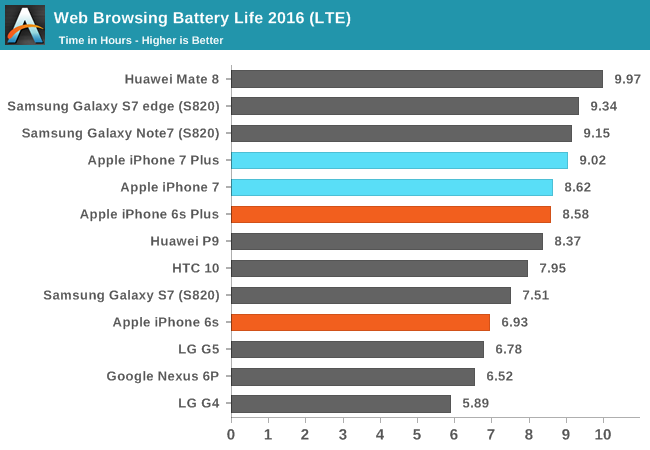
Moving on to LTE battery life the iPhone 7 and 7 Plus both slip a bit, but remain impressive. I suspect that the 20nm Qualcomm modem here is not well-equipped to handle the endless stream of ads that is increasingly a part of most websites. As ads tend to stream in incredibly slowly, the standby power of the modem is a significant factor. Snapdragon 820 devices don’t see nearly the impact here that the iPhone 7 and 7 Plus as their modem is on 14LPP rather than 20SoC. The iPhone 7 remains above the S820 Galaxy S7, but the iPhone 7 Plus is fairly comparable to the iPhone 6s Plus in battery life on LTE.

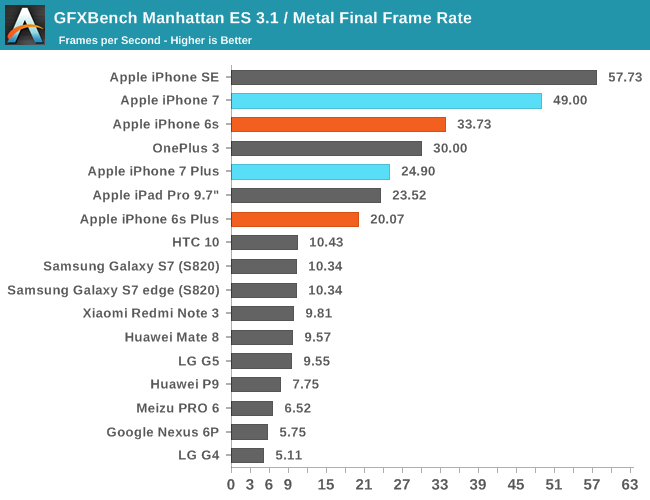
Moving past the web browsing test we use we can take a look at how the iPhone 7 Plus throttles. Unfortunately Basemark OS II was basically broken in this regard for the CPU rundown test so we can only look at how it behaves on Manhattan 3.1, but it's interesting to see how the GPU performance drops about 40% for the iPhone 7 Plus while the iPhone 7 throttles around 20%, because even Manhattan 3.1 is pegged to vsync which means that the GPU can spend much more time idling once a given frame is rendered. It's probably not a surprise here but the iPhone 7 just doesn't last very long here because battery life is strongly SoC-bound. If you attempted to plot battery life as a function of overall SoC utilization, it's entirely possible that the iPhone 7 might last longer than the 7 Plus at the lower bound for utilization, but as soon as you go past web browsing and similarly "light" tasks the 7 Plus and most phablets are going to strongly outperform such a small phone. Here the larger battery helps to get the iPhone 7 Plus nearly another hour of battery life when the SoC is under full, continuous load.
Charge Time
As usual, while battery life is the salient characteristic that determines overall mobility, it’s important to not ignore charge time as there are a number of edge cases where charging has a significant impact on overall mobility. In order to test this we use power measurements at the wall and measure the time it takes from the moment that the charger is plugged in to the moment that it falls below a pre-determined draw from the wall. While this isn’t perfect due to varying levels of DC conversion efficiency and different methods of trickle charging, this method provides at least a reasonable approximation of how long it will take to charge a device.
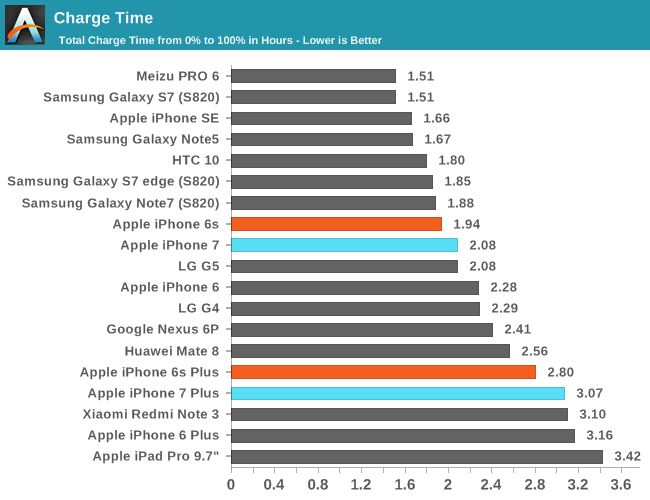
In the case of the iPhone 7 and 7 Plus, Apple continues to ship their standard 5W chargers for US variants. Looking at the results, it’s probably obvious that at least in the case of the iPhone 7 Plus, there is a very real need for Apple to start shipping something with faster charging, as the standard 5W charger takes a full hour longer than most of its competition to charge to 100%. Even the iPhone 7 could use a higher power charger here as using the device while it is charging will significantly impact the charging rate as the charger cannot supply enough power to the board while also charging the battery. And in the case of both phones, the lack of a high power charger doesn't just draw out the total charge time, but it also precludes rapid charging (partially charging a depleted phone very quickly) as well.
It would really be prudent for Apple to start to transitioning to higher power AC adapters at this point. This doesn’t take away from how impressive battery life is, but overall mobility isn’t going to be better than the competition unless you go out of your way to buy an iPad charger.


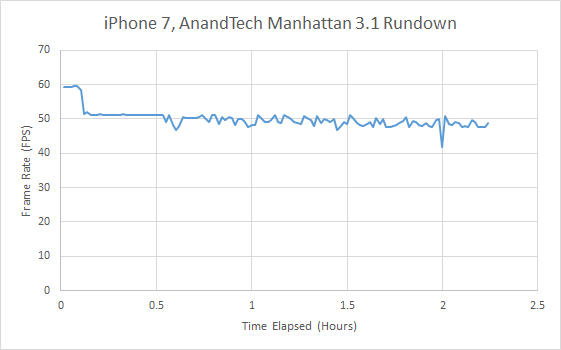
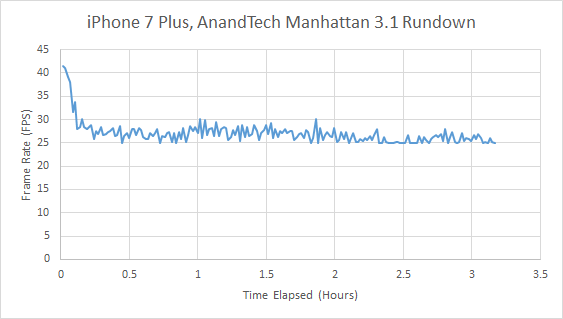
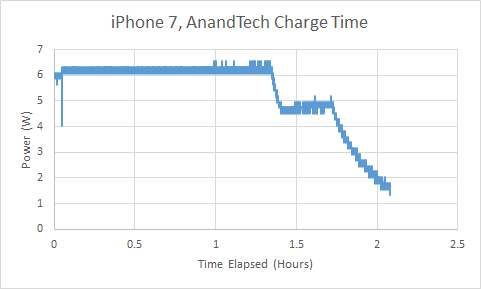
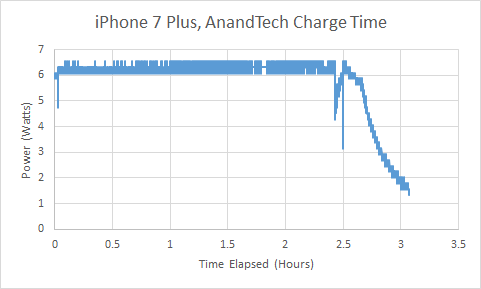








377 Comments
View All Comments
dumbnub - Tuesday, October 11, 2016 - link
I meant "I was like W.H.T. lol".dumbnub - Tuesday, October 11, 2016 - link
lol, why no edit option? ^_^jacropolis - Tuesday, October 11, 2016 - link
People like to see a screen that pops. I'm an iPhone user but there is always a wow factor when I look at a samsung display. I think android central did a blind photo test the other day against most of the major flagships and the s7 ran away with it because the photos are oversaturated and highly sharpened. There is no baseline for correct when it comes to what people like to see. That being said, the only place where color accuracy is really important is when looking at things that are white, people know what white should look like and if it ends up with a pink or blue or yellow hue, it is really distracting. I have noticed this on some android phones when browsing the web, most sites have a white background and I found the neutral white of an my iPhone to look better than most other phones. When i'm looking at a photo though, who doesn't want greener plants and bluer(?) skies? Only other example I can think of it not looking right is if it screws up skin tones.dumbnub - Tuesday, October 11, 2016 - link
On the anandtech review of the nolia 640, they said it has a very accurate display. I'm not saying it doesn't but when I bought one for my dad I was not particually happy with the display. It just looked cheap and little naff to me. It was a cheap phone so I shouldn't have been surprised but these tests aren't worth much IRL IMO.varase - Tuesday, October 11, 2016 - link
So just what is anandtech's opinion on the eye's ability to discern dots on a smartphone display?How many DPI does anantech think you need before the dots become inperceptable? (... or are you talking about using the phone display with some kind of imaging magnifier which certainly falls outside the phone display design criteria?)
techconc - Thursday, October 13, 2016 - link
I'm not surprised that Anandtech has not responded to this question. It's clear that they don't know and are simply chasing specs. Actual display experts have all agreed that existing screens are perfectly sharp for normal vision at normal viewing distances.Vagabondjonez - Tuesday, October 11, 2016 - link
the laser focusing system ob the 10 does employ pdaf+laser. You even made mention of it in your htc 10 review.Vishalaestro - Tuesday, October 11, 2016 - link
would you guys mind posting an indepth review for the lenovo z2 plus ,it's the cheapest snapdragon 820 powered phone. ,it's even cheaper than one plus 3JoeDuarte - Tuesday, October 11, 2016 - link
Anandtech, I have some feedback on the reader experience lately.1. The quality of the writing is bad enough to be distracting. I don't know if this is a new development, if editors were laid off or what, but it's pretty bad.
Example 1: "I don't think that the design is especially notable at this point, but there are only so many ways to make a phone at this point."
Example 2: There's a ton of real/really padding throughout the article like this: "Other OEMs have implemented some form of force sensing, but the implementation is not really executed in a way to improve user experience in a noticeable way. Adoption remained weak as well, with no real widespread support in the ecosystem for such features."
What's the difference between widespread support and real widespread support?
It gets clumsier on the subsequent pages. The quality of the writing is far below expectations for a site as high profile as AnandTech.
The second issue: Your new ad model. On mobile, there is a pop-up ad on every single page of the article, the new kind that has to be dragged or scrolled to the top of the screen until it disappears. Having that kind of ad on every single page is excessive and uncommon – as far as I know you're the only site that does it.
I visit less frequently because of these issues.
toli001 - Tuesday, October 11, 2016 - link
This review is a joke. Iphone's battery life is not even comparable with S7 Edge.Battery life in your review is based only on web browsing. You know that people use they phone for other things as well. Try watching videos and making phone calls and see the difference.
And I don't have to mention higher display resolution.